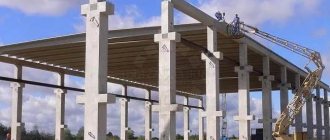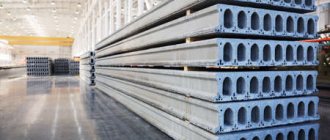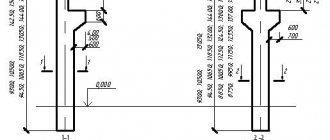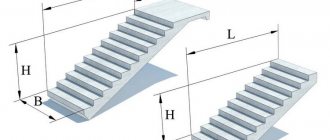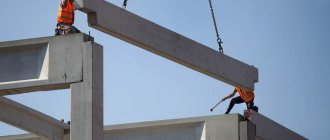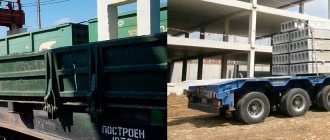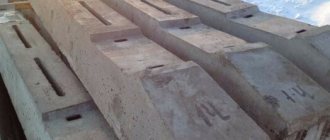Precast concrete enterprises produce products for the construction industry. In the process of constructing residential buildings and industrial facilities, various types of standard products are used, including reinforced concrete lintels. They have high strength and are able to withstand bending loads, thanks to the reinforcement frame filled with heavy concrete. Beams are manufactured in accordance with the requirements of regulatory document 948 84. GOST classifies products by type and contains a set of technical requirements.
Concrete lintels - design and purpose
How are jumpers arranged, according to GOST requirements? They consist of the following parts:
- reinforcement grid, which prevents the formation of cracks and increases strength properties;
- heavy concrete, the dimensions and shape of which, after hardening, comply with the provisions of the standard;
- sling elements designed for ease of transportation and ease of installation work.
The use of frost-resistant concrete allows the product to be used in northern regions at temperatures down to minus 40 degrees. Reinforced with steel reinforcement, reinforced concrete crossbars are characterized by an increased margin of safety and do not crack as a result of the application of bending loads.
Reinforced concrete crossbars are installed in the openings of buildings made of various materials:
- all types of bricks;
- aerated concrete blocks;
- foam block building materials;
- natural stone;
- monolithic concrete.
It is difficult to imagine a house in which there are no windows or doors.
Reinforced lintels perform a number of serious tasks:
- increase the load capacity of openings;
- form a flat surface when building walls;
- compensate for various types of existing loads;
- close the power circuit over window and door openings;
- allow you to create a support contour for installing the roof.
Regulates construction areas in which reinforced concrete lintels can be used, GOST. The dimensions and design of the products also allow them to be used in the transport sector for the arrangement of crane tracks, the construction of overpasses and the laying of tram lines.
ACCEPTANCE RULES
3.1. Jumpers should be accepted in batches in accordance with the requirements of GOST 13015.1-81 and this standard.
3.2. Acceptance of lintels in terms of their strength, rigidity and crack resistance of concrete, frost resistance of concrete, as well as water resistance and water absorption of concrete lintels intended for use in an environment with an aggressive degree of exposure should be carried out based on the results of periodic tests.
3.3. Acceptance of lintels in terms of concrete strength (class or grade of concrete in terms of compressive strength, transfer and tempering strength), compliance of reinforcement and embedded products with design documentation, strength of welded joints, accuracy of geometric parameters, thickness of the protective layer of concrete to the reinforcement, opening width of technological cracks, Concrete surface categories should be made based on the results of acceptance tests and control.
3.4. In cases where the inspection determines that the actual tempering strength of the concrete is lower than the required tempering strength, the lintels should be delivered to the consumer after the concrete reaches a strength corresponding to the class or grade of concrete in terms of compressive strength.
3.5. Acceptance of lintels in terms of the accuracy of geometric parameters, the thickness of the protective layer of concrete before the reinforcement, the category of the concrete surface, and the width of the opening of technological cracks should be carried out based on the results of a single-stage selective inspection.
Main varieties
According to GOST 948, beams differ in marking and are divided into the following types:
- PB jumpers. GOST classifies them as timber partitions having the configuration of a regular parallelepiped with a width of 0.25 m;
- products with the PP index. They are slab-like in appearance, with a minimum cross-sectional width exceeding 0.25 m;
- products with an L-shaped configuration, designated by the letters PG. They have a longitudinally located ledge, which improves the connection with the ceiling elements;
- façade crossbars marked PF. The design provides a quarter ledge for improved covering of openings on the street side of the building.
Depending on the magnitude of the working load, all prefabricated lintels are divided into load-bearing and non-load-bearing.
The current GOST for block lintels provides for design options with inclined end surfaces and side edges. At the same time, the dimensions of the supporting plane are slightly reduced, which does not have a significant effect on the strength characteristics.
Reinforced concrete lintels according to GOST 948-2016 – classification
According to GOST 948-2016, jumpers have different markings. They are classified as follows:
- products with the designation PB. These are timber elements having the shape of a parallelepiped with a maximum cross-sectional width of 25 cm;
Lintels are reinforced concrete beams resting on the masonry walls and transferring to them the load of the masonry and floors overlying the opening.
- products marked PP. Externally they resemble a stove. They have an increased width, the minimum value of which exceeds 25 cm;
- crossbars with PG index. A special feature of these reinforced concrete products is a longitudinal groove to facilitate joining with floor slabs;
- façade type lintels, marked with the letters PF. They also have a quarter recess and provide covering of openings from the front of the house.
The standard tables systematize the dimensions, design loads, masses and material consumption of all types of products. Block and slab beams can be manufactured with sloped end planes, as well as side faces, with a slight reduction in the dimensions of the supporting surface.
Marking of reinforced concrete lintels
The manufacturer of reinforced concrete beams applies markings at the end of each product that meet the requirements of the regulatory document. It is a special designation in the form of an alphanumeric set.
The marking contains the following data:
- profile size corresponding to certain dimensions;
- designation of reinforced concrete products corresponding to the classification;
- length, rounded to the nearest whole number of decimeters;
- the value of the calculated force, which is indicated in kN/m;
- type of reinforcing bars used for stressed beams;
- information about fastening elements and rigging eyes;
- Possibility of using structural beams in special conditions.
The letter index in the designation contains additional information about the availability of outlets for anchor fastening and sling eyes:
- the presence of protruding reinforcement intended for fastening balcony slabs is indicated by the letter “a”;
- The embedded elements or lifting eyes provided for by the beam design are designated by the letter “b”.
The marking and overall dimensions of reinforced concrete structures are specified by GOST 948-84.
The marking provides for special designation in capital letters for the possibility of prolonged use of reinforced concrete crossbars under special operating conditions:
- products for seismic zones contain the index “C”;
- beams for aggressive environments are designated by the letter “P”.
Let's look at how the marking of one of the variants of the reinforced concrete crossbar 5PB30-27 AtIVS-a is deciphered:
- 5 – type of reinforced concrete profile with dimensions 22x25 cm;
- PB - designation of a beam of a timber structure;
- 30 – product length in decimeters, actual dimensions are 2980 mm;
- 27 – the value of the design force, indicated in kN/m, rounded to the nearest whole number;
- AtIVС is an abbreviation for reinforcing bars concreted in a stressed state;
- a – index indicating the presence of protruding rods for fixing the beam.
When deciding on the possibility of using reinforced concrete beams to solve specific problems, you must be able to decipher the markings. It contains complete information about the operational characteristics and design features of the product.
TECHNICAL REQUIREMENTS
2.1. Jumpers should be manufactured in accordance with the requirements of this standard and technical documentation approved in accordance with the established procedure, according to standard design documentation of the 1.038.1-1 series.
2.2. Jumpers must meet the requirements of GOST 13015.0-83:
according to factory readiness;
in terms of strength, rigidity and crack resistance;
according to the actual strength of concrete (at design age, transfer and tempering);
on frost resistance of concrete;
to the quality of materials used to prepare concrete;
to concrete, as well as to materials for preparing concrete lintels intended for use in an environment with an aggressive degree of impact on reinforced concrete structures;
to the shape and size of reinforcement and embedded products and their position in the lintel;
to steel grades for reinforcing and embedded products, including for mounting hinges;
by deviation of the thickness of the protective layer of concrete to the reinforcement;
on corrosion protection;
on the use of molds for the manufacture of lintels.
2.3. Lintels should be made of heavy concrete (average density more than 2200 to 2500 kg/cub.m inclusive) of classes or grades of compressive strength specified in the design documentation for these lintels.
2.4. The normalized transfer strength of concrete lintels with prestressing reinforcement should be 70% of the class or grade of concrete in terms of compressive strength. The transfer of compression forces to the concrete (releasing the tension of the reinforcement) should be carried out after the concrete reaches the required standardized strength.
2.5. The normalized tempering strength of concrete lintels should be (as a percentage of the class or grade of concrete in terms of compressive strength):
70 - when delivering jumpers in the warm season;
90 - the same, in the cold season.
2.6. Reinforcing steel should be used as prestressed longitudinal reinforcement for lintels:
thermally strengthened classes At-V and At-IVC according to GOST 10884-81;
hot-rolled classes AV and A-IV according to GOST 5781-82.
2.7. Reinforcing steel should be used as non-prestressed longitudinal reinforcement of lintels:
hot-rolled class A-III according to GOST 5781-82;
thermomechanically strengthened class At-IIIC according to GOST 10884-81;
reinforcing wire of class BP-I according to GOST 6727-80.
2.8. Transverse reinforcement should be made of hot-rolled reinforcing steel of classes AI and A-III in accordance with GOST 5781-82 or reinforcing wire of class BP-I in accordance with GOST 6727-80.
2.9. Tension of prestressed reinforcement should be done electrothermal or mechanically on stops.
2.10. The stress values in the prestressed reinforcement, monitored after tensioning it on the stops, must correspond to those given in the design documentation for the lintels.
The values of the actual stress deviations in the prestressed reinforcement should not exceed 5% when tensioned mechanically, and when tensioned by an electrothermal method - the values
360 3600 30 + —-, MPa (300 + —-, kgf/sq.cm),
where is the length of the tension rod (the distance between the outer edges of the stops), in meters.
2.11. The values of actual deviations of the geometric parameters of the jumpers should not exceed the limits specified in the table. 8.
Table 8
mm
| Name of deviation of geometric parameter | Name of geometric parameter | Prev. off |
| Deviation from linear size | Jumper length: | |
| up to 2500 | 6 | |
| St. 2500 » 4000 | 8 | |
| » 4000 | 10 | |
| Jumper width and height | 5 | |
| Position of tabs, notches and holes | 5 | |
| Position of embedded products: | ||
| in the plane of the jumper | 5 | |
| from the plane of the jumper | 3 | |
| Deviation from straightness | Straightness of the profile of the front surface of the lintel: | |
| length up to 2500 at a given length 1000 | 3 | |
| length St. 2500 to 4000 along the entire length of the lintel | 3 | |
| length St. 4000 along the entire length of the jumper | 4 |
2.12. The following categories of concrete lintel surfaces are installed:
A3 - bottom and side surfaces;
A7 - other surfaces.
Requirements for the quality of surfaces and appearance of lintels are in accordance with GOST 13015.0-83.
2.13. Cracks are not allowed in the concrete of lintels supplied to the consumer, with the exception of:
shrinkage and other surface technological cracks, the width of which should not exceed 0.1 mm;
cracks from compression of concrete in prestressed lintels, the width of which should not exceed the values specified in the design documentation for these lintels.
Concrete lintels - dimensions and weight of products
The dimensions of reinforced concrete lintels for windows and doors, as well as other types of beams, are regulated by the standard. The rounded dimensions of products marked PB are:
- length 1–6 m;
- width – 1.2–2.5 dm;
- height – 0.65–5.85 dm.
The assortment is so diverse that it makes no sense to list all the typical dimensions.
Beams with the designation PP have the following parameters:
- length – 1.1–3 m;
- width – 3.8–5.1 dm;
- height – 0.65–2.2 dm.
Products of the PG brand are characterized by the following sizes:
- length 1.5–6 m;
- width equal to 2.5–5.1 dm;
- height – 2.9–5.85 cm.
The dimensions of the PF crossbars, differing in the standard width of 2.5 dm, are:
- length – 0.8–4.3 m;
- height – 1.4–2.9 dm.
The weight of the beams depends on the dimensions and ranges from 20 kg to 2.5 tons.
Bar lintels
| Name | Weight, kg | Size, mm L – length, B – width, H – height | Price for 1 piece. with VAT, rub | |||
| 2 PB 10-1p | 43 | 1030 | 120 | 140 | from 615 | |
| 2 PB 13-1p | 54 | 1290 | 120 | 140 | from 830 | |
| 2 PB 16-2p | 65 | 1550 | 120 | 140 | from 1105 | |
| 2 PB 17-2p | 71 | 1680 | 120 | 140 | from 1165 | |
| 2 PB 19-3p | 81 | 1940 | 120 | 140 | from 1380 | |
| 2 PB 22-3p | 92 | 2200 | 120 | 140 | from 1440 | |
| 2 PB 25-3p | 103 | 2460 | 120 | 140 | from 1495 | |
| 2 PB 26-4p | 109 | 2590 | 120 | 140 | from 1500 | |
| 2 PB 29-4p | 120 | 2850 | 120 | 140 | from 1825 | |
| 3 PB 34-4p | 222 | 3370 | 120 | 220 | from 2595 | |
| 3 PB 18-8p | 110 | 1810 | 120 | 220 | from 1825 | |
| 3 PB 21-8p | 132 | 2070 | 120 | 220 | from 1940 | |
| 3 PB 25-8p | 150 | 2460 | 120 | 220 | from 2270 | |
| 3 PB 27-8p | 180 | 2720 | 120 | 220 | from 2490 | |
| 3 PB 30-8p | 197 | 2980 | 120 | 220 | from 2705 | |
| 3 PB 13-37p | 82 | 1290 | 120 | 220 | from 1605 | |
| 3 PB 16-37p | 102 | 1550 | 120 | 220 | from 1940 | |
| 3 PB 18-37p | 119 | 1810 | 120 | 220 | from 2155 | |
| 5 PB 21-27p | 285 | 2070 | 250 | 220 | from 4645 | |
| 5 PB 30-27p | 410 | 2980 | 250 | 220 | from 6350 | |
| 5 PB 27-37p | 375 | 2720 | 250 | 220 | from 6240 | |
| 5 PB 30-37p | 410 | 2980 | 250 | 220 | from 7120 | |
| 9 PB 22-3p | 125 | 2200 | 120 | 190 | from 1825 | |
| 9 PB 25-3p | 140 | 2460 | 120 | 190 | from 2045 | |
| 9 PB 26-4p | 148 | 2590 | 120 | 190 | from 1825 | |
| 9 PB 29-4p | 167 | 2850 | 120 | 190 | from 1940 | |
| 9 PB 16-8p | 88 | 1550 | 120 | 190 | from 1105 | |
| 9 PB 18-8p | 103 | 1810 | 120 | 190 | from 1550 | |
| 9 PB 21-8p | 120 | 2070 | 120 | 190 | from 1825 | |
| 9 PB 25-8p | 140 | 2460 | 120 | 190 | from 2155 | |
| 9 PB 27-8p | 155 | 2720 | 120 | 190 | from 2320 | |
| 9 PB 13-37p | 70 | 1290 | 120 | 190 | from 1440 | |
| 9 PB 16-37p | 90 | 1550 | 120 | 190 | from 1605 | |
| 9 PB 18-37p | 103 | 1810 | 120 | 190 | from 1940 | |
| 10 PB 18-27p | 215 | 1810 | 250 | 190 | from 3645 | |
| 10 PB 21-27p | 246 | 2070 | 250 | 190 | from 4145 | |
| 10 PB 25-27p | 297 | 2460 | 250 | 190 | from 4915 | |
| 10 PB 27-27p | 323 | 2720 | 250 | 190 | from 5745 | |
| 10 PB 25-37p | 292 | 2460 | 250 | 190 | from 5245 | |
| 10 PB 27-37p | 323 | 2720 | 250 | 190 | from 6400 | |
Size table according to GOST 948
The dimensions of concrete lintels for all designs are contained in the tables of the regulatory document. Table values are used by professional builders and design specialists when selecting products to perform specific construction tasks.
The diameter of the reinforcement used directly depends on what type of reinforced concrete lintel will be made - block or slab
Along with the dimensions of the beams, the standard tables contain the following information:
- product code and marking;
- design loads;
- reference mass;
- the required amount of materials for the manufacture of products.
The tabular information allows you to select crossbars taking into account the required safety margin.
How to make reinforced concrete lintels according to GOST 948
The manufacturing process can be carried out in a production environment or independently. To make it yourself, you should prepare:
- wood or moisture-resistant plywood for making formwork;
- steel bars intended for reinforcement cage;
- knitting wire, which allows you to securely fix steel reinforcement;
- concrete mixture prepared in the volume required for pouring.
The algorithm for self-manufacturing crossbars is as follows:
- Select the type of crossbar that meets the dimensional requirements of the standard.
- Develop a formwork drawing taking into account the configuration of the element being formed.
- Make the formwork, ensuring its tightness and strength.
Reinforced concrete beam lintels are the most common type of product used to design openings in residential, industrial and civil buildings
- Place polyethylene to make it easier to remove the finished product.
- Cut steel rods with a diameter of 10–12 mm into blanks.
- Tie 4 longitudinal rods into a lattice using tying wire.
- Place the frame in the mold on special pads (with an equal gap to the surface).
- Prepare a concrete mixture of the required grade and pour it into the formwork.
- Plan the top plane of the concrete mass and lay polyethylene on it.
- Moisten the molded product periodically to maintain moisture.
- Remove the crossbar from the mold one month after concreting.
This technology allows you to independently produce products with small dimensions, which are then mounted in the opening area. Large-sized and massive structures that absorb significant forces are manufactured at specialized enterprises.
CONTROL AND TEST METHODS
4.1. Monitoring and assessment of the strength, rigidity and crack resistance of lintels should be carried out in accordance with GOST 8829-85.
Load testing of lintels to control their strength, rigidity and crack resistance should be carried out when the concrete reaches a strength corresponding to its class or grade in terms of compressive strength.
4.2. The strength of concrete lintels should be determined in accordance with GOST 10180-90 on a series of samples made from a concrete mixture of the working composition and stored under conditions in accordance with GOST 18105-86.
When testing lintels using non-destructive methods, the actual transfer and tempering compressive strength of concrete should be determined by the ultrasonic method in accordance with GOST 17624-87 or mechanical devices in accordance with GOST 22690-80, as well as other methods provided for by the standards for concrete testing methods.
4.3. The frost resistance of concrete should be determined according to GOST 10060-87 on a series of samples made from a concrete mixture of the working composition.
4.4. The water resistance of concrete lintels intended for use in an environment with an aggressive degree of exposure should be determined according to GOST 12730.0-78 and GOST 12730.5-84 on a series of samples made from a concrete mixture of the working composition.
4.5. The water absorption of concrete lintels intended for operation in an environment with an aggressive degree of impact on reinforced concrete structures should be determined according to GOST 12730.0-78 and GOST 12730.3-78 on a series of samples made from a concrete mixture of the working composition.
4.6. Methods of control and testing of reinforcement and embedded products - according to GOST 10922-90.
4.7. Measurement of stresses in prestressed reinforcement, controlled at the end of tension, should be carried out in accordance with GOST 22362-77.
4.8. Methods of control and testing of initial raw materials used for the manufacture of jumpers must comply with established standards or technical specifications for these materials.
4.9. Dimensions, deviation from straightness, thickness of the protective layer of concrete to the reinforcement, position of embedded products, quality of concrete surfaces and appearance of lintels should be checked by the methods established by GOST 13015.0-83, GOST 13015.1-81 - GOST 13015.3-81 and GOST 13015.4-84.
Formwork and its strengthening
The technology also makes it possible to fill beams directly above the opening.
To ensure the strength of concrete structures reinforced with steel reinforcement, formwork from the following materials is assembled in the opening area:
- metal sheets;
- wooden boards;
- moisture-resistant plywood;
- particle boards.
The height of the lintel is selected based on the calculated load on the opening.
A form is assembled from blanks, which is fixed with wire or bars against possible deformations during concreting. It is important to think about how the formwork structure will be disassembled after the crossbar has hardened. For this, a polyethylene film is used, which is placed inside the mold or the metal surface is lubricated with oil. A reinforcement cage is placed inside the formwork, which ensures the integrity of the structure and prevents displacement. Vertical supports should also be provided for additional fastening of the form.
Building up the structure
Jumper installation diagram.
It is allowed to support the lintels on a brick wall SNiP by building up the structure on site. For this it is important to use formwork, i.e. box It must be selected in such a way that the lower part of the formwork or the bottom completely follows the dimensions of the opening. The formwork is nailed to the side parts, which should extend at least 20-25 cm into the structure. The side of such a structure is limited by brickwork. To ensure an accurate fit of the board to the wall, experienced builders recommend mounting the bricks in such a way that they protrude half the brick on both sides.
The box has small protrusions for installation, the board is attached and lies perfectly flat. Several rows of bricks are placed at the bottom of the structure (to hold the bottom of the box). This technology ensures strong and reliable fixation of the formwork. Then the elements are placed in the box and filled with solution.
For strong, reliable coupling of reinforcement elements, they can be placed in a joint ball of mortar from the side of the side stop or between the bricks. At the final stage, the side protruding bricks can be cut off using a grinder or safely used to tie up window decor parts.
The construction of one-story, small houses does not require massive reinforced concrete structures. Therefore, elements are selected for them from ready-made metal objects. More often they use a channel, ordinary reinforcement bars, a metal corner or strips. These supports are very lightweight, easy to use and quick to install.
Before installing such structures, it is important to correctly calculate the jumpers. There is a risk of the structure sagging, which could jam or destroy the window.
According to SNiP standards, such metal supports can bend no more than 1/200 of the length of the support itself.
To correctly calculate such installations, you will need the help of a specialist. If the calculation of the jumper is carried out independently, it is recommended that you familiarize yourself with the SNiP methods.
GOST 948 84 “Jumpers” - basic provisions
The regulatory document provides extended information for builders and designers:
- application area;
In a non-load-bearing wall, the lintels are the same size
- types of products;
- dimensions of various types of products;
- technical specifications;
- marking features;
- product acceptance rules;
- quality control methods;
- transportation rules;
- storage specifics.
Compliance with the provisions of the standard guarantees the quality of the products produced.
Content
1 Scope……………………………………………………………………………………………………………………1
2 Normative references……………………………………………………………………………………………………………………………………1
3 Terms and definitions…………………………………………………………………………………………………………….2
4 Types, main parameters and dimensions………………………………………………………………………………………….2
5 Technical requirements…………………………………………………………………………………………………………….16
6 Acceptance rules and completeness…………………………………………………………………………………………..17
7 Control and testing methods……………………………………………………………………………………………………………18
8 Labeling, transportation and storage……………………………………………………………………………….18
Appendix A (mandatory) Grades of concrete lintels for frost resistance…………………………………20
Bibliography…………………………………………………………………………………………………………………………….. 21
INTERSTATE STANDARD
REINFORCED CONCRETE JUMPERS FOR BUILDINGS WITH BRICK WALLS
Specifications
Reinforced concrete lintels for bnck wall buildings Specifications
Date of introduction: 2017—03—01
How to calculate the size of reinforced concrete lintels
To select crossbars, taking into account the strength characteristics and operating loads, it is necessary to perform the calculation correctly. It includes the following stages:
- calculation of the load acting on the structure;
- determination of the maximum permissible bending moment;
- selection of the optimal section.
It is advisable to entrust the calculations to professionals who are familiar with the calculation methods and take into account all factors in full.
Calculation of the cross-section of concrete lintels
Table of cross-sections for standard lintels
When choosing reinforced concrete lintels, you should count on the load from the floors and the pressure of freshly laid masonry, which corresponds to 1/3 in warm weather and the entire span in the winter season. Important: only permissible if there are protrusions.
The calculation consists of the following steps:
- Determination of the load that acts on the jumper.
- Determination of the maximum bending moment.
- Selection of lintel cross-section.
The load on the lintel can be determined from the weight of the masonry or the dead weight of the metal lintel. To carry out this type of work, it is better to turn to professionals, as in order to make an accurate calculation you will need certain knowledge and skills.
Installation and installation of reinforced concrete lintel
This is approximately how the insulation of reinforced concrete lintels in a window opening works
The installation of reinforced concrete lintels is carried out strictly after masonry using a water level to ensure correct installation. Each type of jumper has its own installation system:
- Bars - installed in load-bearing walls, take on the load from the floors.
- Slab - installed in self-supporting walls, they only take the load of the wall, which they do not rely on.
A detailed video on how to correctly install a reinforced concrete lintel using a truck crane in a window opening.
When installing, jumpers must be mounted in strict compliance with the position relative to other structural elements. Lintels up to 2 meters can be laid manually; for lintels longer than 2 m, a crane must be used. Installation must be carried out according to the recommendations of GOST and SNIP. To increase the strength of joints, it is advisable to reinforce the seams with mesh.
Price and cost
If you are interested in reinforced concrete door, window, slab, timber, beam or facade lintels, we advise you to look through the catalog to get more detailed information about their cost or contact a manager who will answer all your questions. Delivery is carried out using wooden spacers, the thickness of which is more than 25 mm - for the safe transportation of products.
Useful tips
When performing work, pay attention to the following points:
- the height of the beam, which must be at least 5% of the height of the opening;
- the width of the structure, which must rest completely on the surface;
- diameter of reinforcement cage rods, ranging from 10 to 14 mm;
- immobility of the structure, which can be loaded a month after pouring;
- quality workmanship and reliability of installation, guaranteeing the absence of cracks;
- thorough compaction of the concrete mixture to remove air pockets.
In the process of manufacturing and installation of concrete crossbars reinforced with reinforcing mesh, one should be guided by the provisions of the regulatory document. The products are in demand in the construction industry and provide an increased margin of safety, as well as durability of building structures. When designing, it is necessary to focus on the provisions of GOST 948 84. This will avoid problematic situations associated with the formation of cracks and violation of the integrity of building structures.
LABELING, STORAGE AND TRANSPORTATION
5.1. Marking of jumpers is in accordance with GOST 13015.2-81. Markings and signs should be applied to the end or top sides of each jumper. On the end side of jumpers that have sling holes (instead of mounting loops), the installation mark “Top of the product” must be applied in accordance with GOST 13015.2-81.
It is allowed, by agreement between the manufacturer and the consumer and the design organization - the author of the project for a particular building, instead of marks, to apply on the lintels their abbreviated symbols adopted in the design documentation of a particular building.
5.2. Requirements for the document on the quality of jumpers supplied to the consumer are in accordance with GOST 13015.3-81.
Additionally, the document on the quality of lintels must indicate the grade of concrete for frost resistance, and for lintels intended for use in an environment with an aggressive degree of exposure, the water resistance and water absorption of concrete (if these indicators are specified in the order for the production of lintels).
5.3. Jumpers should be transported and stored in accordance with the requirements of GOST 13015.4-84 and this standard.
5.3.1. Jumpers should be transported and stored in containers sorted by brand and laid in working position.
It is allowed to transport and store jumpers stacked without containers.
5.3.2. Pads and gaskets between rows of lintels must be at least 25 mm thick and located vertically, one above the other, at a distance of 200-250 mm from the end of the lintel.
5.3.3. The height of the stack of lintels should be no more than 2 m.
5.3.4. Lifting, loading and unloading of jumpers should be carried out in packages with a crane using special load-handling devices, and individual jumpers should be grabbed by the mounting loops or the provided sling holes.
5.3.5. When transporting, the jumpers should be placed in vehicles in the working position, with the longitudinal axis in the direction of movement of the vehicle.


